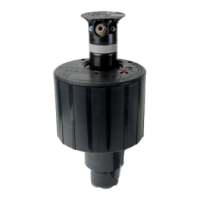The sprinkler shall be capable of identifying
the use of effluent water via a lavender-
colored cap marking. The sprinkler cap shall
indicate model designation, nozzle number
and manufacturing date code.
The sprinkler shall be available in the
following electric valve-in-head activation
types:
Standard Solenoid
The sprinkler shall incorporate an electrical
solenoid for activation of the integrated
control valve. The solenoid operator shall
be suitable for 24 VAC, 50/60 Hz service
with inrush of 0.30 A @ 50/60 Hz, and
holding of 0.20 A @ 50/60 Hz. The
standard solenoid shall be capable of
withstanding a voltage surge up to 9k volts
in the common and normal modes without
failure.
Spike Guard Solenoid
The sprinkler shall incorporate an electrical
solenoid for activation of the integrated
control valve. The solenoid operator shall
be suitable for 24 VAC, 50/60 Hz service
with inrush of 0.12 A @ 50/60 Hz, and
holding of 0.10 A @ 50/60 Hz. The Spike
Guard Solenoid shall be capable of
withstanding a voltage surge up to 20k volts
in the common and normal modes without
failure.
Nickel-Plated Spike Guard Solenoid
The Nickel-Plated Spike Guard Solenoid
shall be suitable for 24 VAC, 50/60 Hz
service with inrush of 0.12 A @ 50/60 Hz,
and holding of 0.10 A @ 50/60 Hz. It shall
be capable of withstanding a voltage surge
up to 20k volts in the common and normal
modes without failure. It shall have a nickel-
plated core to provide additional corrosion-
resistance in potable and non-potable water
applications.
DC Latching Solenoid
The DC latching solenoid shall be activated
by a momentary low-voltage pulse that
moves the plunger from the “OFF” position
to the “ON” position where it is maintained
by a permanent magnet in the solenoid. To
deactivate, a second momentary low-volt
pulse is applied to move the plunger from
the “ON” to the “OFF” position. This
activation type is generally used with a GDC
module that is remotely located.
Integrated GDC Module
The Integrated GDC Module activation
type incorporates the GDC module inside
the compartment of the sprinkler and
includes a DC latching solenoid for
activation of the control valve. The DC
latching solenoid shall be activated by the
Integrated GDC module with a momentary
low voltage pulse that moves the plunger
from the “OFF” position to the “ON”
position where it is maintained by a
permanent magnet in the solenoid. To
deactivate, a second momentary low-volt
pulse is applied to move the plunger from
the “ON” to the “OFF” position.
The sprinkler shall be developed and
manufactured by an ISO 9001-certified
facility. The sprinkler shall be model
number __________ and shall be
manufactured by The Toro Company,
Irrigation Division.
Recommended Installation Procedures
The INF55 sprinkler is designed specifically
for turf areas requiring _____ coverage.
These products offer the most economical
method of irrigation where flows and system
pressures are available to support a greater
radius.
The INF55 sprinkler should be specified
for installation on a Toro swing joint. The
swing joint should be specified as a triple-
swing type, allowing movement up, down,
laterally and at an angle-to-grade. The
sprinkler should be installed with the body
cover at grade.
Individual sprinkler head control is
accomplished using a single INF55 valve-in-
head sprinkler per controller station. Use of
the valve-in-head model will allow individual
station control, and is particularly useful for
irrigating distinct turf regions at unique
application rates.
INF55 sprinklers are engineered to provide
a smooth, consistent curtain of water across
the arc, with provision made for head-to-
head coverage. For proper spacing, ensure
that system design and installation accounts
for prevailing wind conditions and body
cover angle-to-grade.
It is recommended that sprinklers are
installed 2” (5cm) from hardscaping and 6”-
12” (15,2-30,5cm) from buildings or other
vertical impediments to allow for normal
maintenance procedures and to minimize
overspray on buildings. Where possible,
sprinkler heads should be installed in a
manner that will minimize nozzle stream
contact with trees, controller enclosures,
shrubbery or other obstructions.

